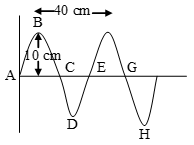Relation Between Wave Velocity, Frequency And Wavelength For A Periodic Wave
\( \text{wave velocity}=\frac{\text{distance covered}}{\text{Time}\,\,\text{taken}} \)
\( =\frac{\text{wave}\,\text{length}}{\text{Time}\,\text{taken}} \)
\( \text{or v}=\frac{\lambda }{T}\text{ }……\text{ (1)} \)
\( \text{since }\!\!~\!\!\text{ }v=\frac{\text{1}}{\text{T}}\text{, equation }\left( \text{1} \right)\text{ can also be written as} \)
\( \text{v}=v\lambda \text{ }……\text{ (2)} \)
Wave Velocity = Frequency × Wave Length
Relation Between Wave Velocity, Frequency And Wavelength Example Problems With Solutions
Example 1: If 50 waves are produced in 2 seconds, what is its frequency ?
Solution: Frequency,
\( v=\frac{\text{Number}\,\text{of}\,\text{wave}\,\text{produced}}{\text{Time}\,\text{taken}} \)
\( =\frac{50}{2}=25\text{ Hz} \)
Example 2: A source produce 50 crests and 50 troughs in 0.5 second. Find the frequency.
Solution: 1 crest and 1 trough = 1 wave
∴ 50 crests and 50 troughs = 50 waves
\( \text{Now, Frequency, }v=~\frac{\text{Number}\,\text{of}\,\text{wave}}{\text{Time}} \)
\( =\frac{50}{0.5}=100\text{ Hz} \)
Example 3: Sound waves travel with a speed of 330 m/s. What is the wavelength of sound waves whose frequency is 550 Hz ?
Solution: Given velocity, v = 330 m/s,
Frequency, \(\upsilon\) = 550 Hz
\(\therefore \text{ }wavelength,~~\text{ }\lambda =\frac{\text{v}}{\upsilon }\)
\( =\frac{330}{550}=0.6\text{ }m \)
Example 4: The wave length of sound emitted by a source is 1.7 × 10-2 m. Calculate frequency of the sound, if its velocity is 343.4 ms-1.
Solution: The relation ship between velocity, frequency and wave length of a wave is given by the formula v = \(\upsilon\) × λ
Here, velocity, v = 343.4 ms-1
frequency \(\upsilon\) = ?
and wavelength, λ= 1.7 × 10-2 m
So, putting these values in the above formula, we get :
343.4 = \(\upsilon\) × 1.7 × 10-2
\( v=\frac{343.4}{1.7\times {{10}^{-2}}} \)
\( =\frac{343.4\,\times {{10}^{2}}}{1.7} \)
= 2.02 × 104 Hz
Thus, the frequency of sound is 2.02 × 104 hertz.
Example 5: A wave pulse on a string moves a distance of 8m in 0.05 s.
(i) Calculate the velocity of the pulse.
(ii) What would be the wavelength of the wave on the same string, if its frequency is 200 Hz ?
Solution: (i) Velocity of the wave,
\( \text{v}=\frac{\text{Distance covered}}{\text{Time}\,\text{taken}}=\frac{8m}{0.05s}=160\text{ m/s} \)
(ii) Periodic wave has the same velocity as that of the wave pulse on the same string.
\( \therefore \text{ Wavelength, }\lambda =~\frac{\text{v}}{v}=~\frac{160\,m/s}{200\,Hz}~=0.8\text{m} \)
Thus, the wavelength of the wave is 0.8 m.
Example 6: A person has a hearing range of 20 Hz to 20 kHz. What are the typical wavelengths of sound waves in air corresponding to these two frequencies ? Take the speed of sound in air as 340 m/s.
Solution: Given : \({{v}_{1}}\) = 20 Hz, V = 340 m/s
\( \therefore \text{ }{{\lambda }_{1}}=\frac{\text{v}}{{{v}_{1}}}=\frac{340}{20}=17\text{ m} \)
\({{v}_{2}}\) = 20 kHz = 20,000 Hz, v = 340 m/s
\( \therefore \text{ }{{\lambda }_{2}}=\frac{\text{v}}{{{v}_{2}}}=\frac{340}{20,000}=1.7\times {{10}^{-2}}m=1.7cm \)
∴ The typical wavelengths are 17 m and 1.7 cm.
Example 7: A longitudinal wave is produced on a toy string. The wave travels at a speed of 30 cm/s and the frequency of the wave is 20 Hz. What is the minimum separation between the consecutive compressions of the string ?
Sol. Given, Velocity, v = 30 cm/s
Frequency, \(\upsilon\) = 20 Hz
Minimum separation between the two consecutive compressions is equal to one wavelength λ and
\(\lambda =\frac{\text{v}}{v}=\frac{30\,cm/s}{20\,Hz}=1.5\text{ cm}\)
Example 8: Wave of frequency 200 Hz produced in a string is represented in figure. Find out the following

(i) amplitude
(ii) wavelength
(iii) wave velocity
Solution: (i) Amplitude = Maximum displacement = 10 cm
(ii) Wavelength λ = Distance between two successive crests = 40 cm
(iii) Now, frequency, n = 2 Hz
Wavelength, λ= 40cm = 0.4 m
∴ Wave velocity, v = \(\upsilon\)λ
= 200 × 0.4 m/s
= 80m/s
Example 9: A stone is dropped into a well 44.1 m deep. The sound of splash is heard 3.13 seconds after the stone is dropped. Calculate the velocity of sound in air.
Solution: First we calculate the time taken by the stone to reach the water level by using the relation:
s = ut + \(\frac { 1 }{ 2 }\) gt2
Here s = 44.1 m, u = 0, g = 9.8 m/s2
∴ 44.1 = 0 × t + \(\frac { 1 }{ 2 }\) × 9.8 × t2
\( {{t}^{2}}=\frac{44.1\times 2}{9.8}=9 \)
or t = 3 s
Time taken by the sound to reach the top of the well
t2 = 3.13 – 3 = 0.13 s
Now, speed of sound
\( \frac{\text{Distance}}{\text{Time}}=\frac{44.1\,m}{0.13\,s}=339.2\text{ m/s} \)